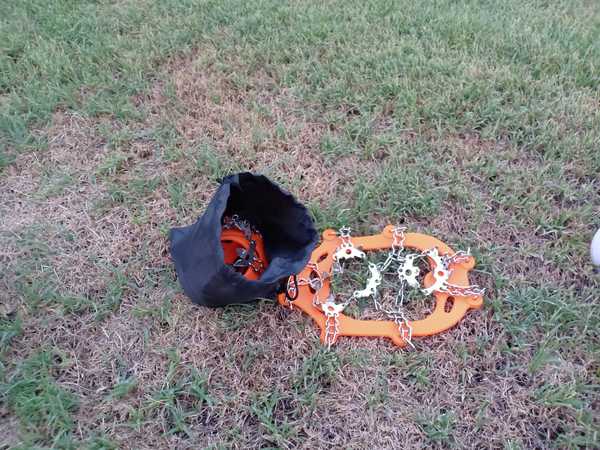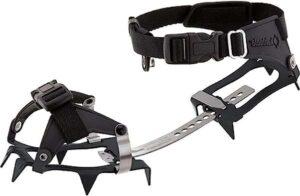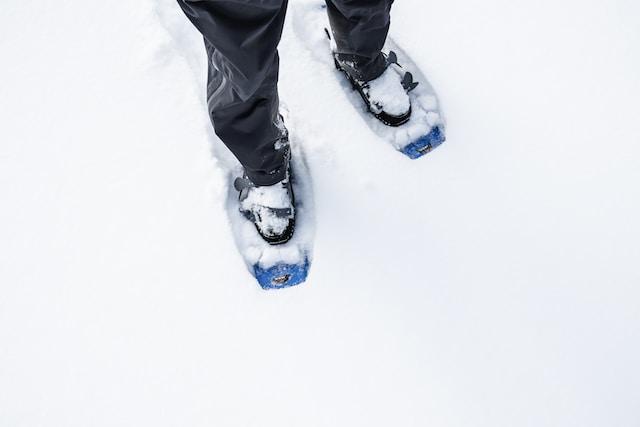Hiking in snow and ice during winter is an enjoyable and unique experience that also comes with the challenge of hiking on the snow or slippery ice surface, which can lead to severe injuries.
Related: Best microspikes
That’s where crampons and microspikes come into the pictures as handy gear for snow hiking. But many hikers, especially newcomers, need to understand whether they need crampons or microspikes and the difference between them.

Unfortunately, despite the clear difference between microspikes and crampons, many sellers mention both terms in their product headlines or descriptions regardless of their significant differences to bring customers looking for either. This creates confusion and leads to unwanted decisions and later having to return the gear.
This article will compare crampons vs. microspikes and suggest which is better for a particular situation.
What are Microspikes
Microspikes are traction devices mainly designed for low to moderate flat ice and snow surfaces. With their low-profile construction, these outdoor gear provides excellent grip on flatter terrain and icy surfaces.
They are lightweight and compact, usually built with stretchable, highly quality rubber with small spikes to attach to boots.
When to Use Microspikes
Microspikes provide traction on snow and packed icy surfaces, especially low to medium and flat terrains. So you can use microspikes on your regular snow and ice hiking trips.
But if you want to climb or trek on steep snow or ice, they are not suitable, and you should choose crampons because microspikes possess small metal spikes unlike crampons, so it will be hard to provide enough traction while climbing so there will be a risk of falling.
They are suitable for most flat terrains and are lightweight and easy to carry, unlike crampons. If you are concerned about weight, then Microspikes are a good choice.
Top Recommendations For Microspikes
We have already reviewed the best microspikes based on different performance parameters; you can look at them. However, here we are sharing few our top recommendations:
How to Put on Microspikes
To effectively and safely put on microspikes;

- Clean your boots from any debris.
- Lay the microspikes flat on the ground.
- Check the head section(mentioned on spikes) and put it on the head.
- Pull up flexible rubber and ensure it is snug but not overly tight
- Adjust the straps or buckles on the instep to ensure a snug fit
Pros and Cons of Microspikes
Pros
- Lightweight
- Practical in most situations
- Budget-friendly
- Easy to use
- Better for flat terrains
Cons
- Not suitable for sloppy ice
- Not good for mountaineering
What are Crampons
Crampons are outdoor devices designed primarily for aggressive traction on icy slopes and climb with several large spikes on the bottom. Crampons provide climbers and hikers with improved traction, much more the microspikes, on icy or packed snow surfaces to prevent slips and falls for slopy ice surfaces.
They are designed in such a way that they dig into the frozen terrain or dense snow for better movement on challenging icy landscapes. Modern crampons are typically constructed from strong materials like steel or aluminum alloy for durability.
When to Use Crampons
Crampons provide very aggressive tractions and are mainly used for ice slopes or for professional mountaineers to climb icy or technical mountains during snow. They consist of metal spikes attached to a sturdy frame that can be fitted onto the boot.
In most cases, during regular hiking, you don’t need crampons, as microspikes will be more than enough. Also, if you are concerned about weight, crampons are unsuitable as they are heavier than microspikes.
But if you are trekking on challenging icy terrains, you should opt for crampons instead of microspikes as you need more grip on such sloppy and slippery icy terrains.
Additionally, they become necessary when facing mixed climbing routes with rock, ice, and snow. These situations require increased stability and grip to ensure safety while ascending or descending.
Top Recommendations For Crampons
Here we are sharing few our top recommendations:

Pros and Cons of Crampons
Pros
- Good for mountaineering
- Great traction
- Suitable for sloppy ice climbing
- Easy to use
Cons
- Heavey
- Need more energy to walk
Crampons vs. Microspikes Comparison
We have meticulously compared crampons and microspikes in a detailed comparison table below to provide a comprehensive understanding of the differences and appropriate uses between crampons and microspikes.
Crampons are rugged, metal traction devices with multiple spikes or points designed for traversing icy or steep terrain. They excel in mountaineering and ice climbing, offering superior stability and grip on demanding surfaces.
On the other hand, Microspikes are a more accessible option for those engaging in less technical activities, such as hiking or trail running on packed snow or icy trails. Microspikes are not the same as crampons, as shown in the below comparison table.
| Crampons | Microspikes |
| Suitable for Icy Slopes and Climbs | Low to medium snow and flat terrains |
| Heavy | Lightweight |
| Big spikes chain | Small spikes chain |
| Used by Alpine hiker and climbers and mountaineers | User on normal hikes, walks on snow |
| Durable | Less durable |
| Steel or Aluminium | Made of rubber strap |
Snowshoes Alternative Option
If you want to walk on powdery or fluffy snow, snowshoes are another excellent option for relatively flat terrain. They are much wider than boots and other traction devices, and you can walk with them slowly. They distribute the weight over a larger area of fluffy snow to avoid a person sinking into the snow.

These are usually made from lightweight materials such as aluminum or carbon fiber to prevent putting extra load on leggings during extended treks.
We cannot compare snowshoes directly with crampons or microspikes as they are for different purposes but related to snow walks.
FAQs
Are Crampons Better Than Microspikes?
Crampons and microspikes are valuable gear for traction on icy or snowy terrains. Still, we cannot say if crampons are better than micro spikes because it depends on the landscapes and conditions where a person will use them.
As we differ both in the comparison table(above), crampons are used for more traction and stability on steep ice or mountain or mixed terrain, so they are useful for mountaineering or technical ice climbing. They offer superior grip due to their aggressive design, which allows for secure footing even in challenging environments.
On the other hand, microspikes feature smaller spikes that are more suitable for less technical trails or winter hiking. And in most conditions, you don’t even require crampons, as microspikes are more than enough.
Do I need microspikes if I have crampons?
Microspikes and crampons are traction devices, but one provides more traction than the other. For example, crampons are better suited for challenging icy terrains but are heavier than microspikes.
Now the question is whether to buy Microspikes or not if you already have crampons. Suppose you regularly go snow hiking on regular and flatter terrains. In that case, we advise going for microspikes because it’s more challenging to hike in crampons as they dig more in snow than microspikes, so they will require more energy to walk.
But if you want to go on a trek or climb, especially on slopy ice terrains, then you should have crampons.
Conclusion
In conclusion, crampons and microspikes offer distinct levels of traction and are suitable for different purposes. Crampons provide much aggressive traction and are suitable for technical mountaineering or sloppy ice-climbing scenarios. On the other hand, microspikes are lightweight traction devices designed for less extreme situations, such as winter hiking or trail running. They are suitable for packed snow and flat terrains.
